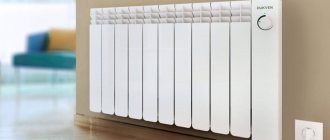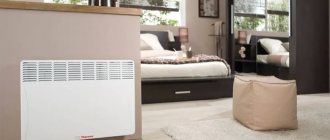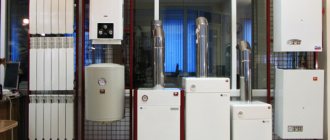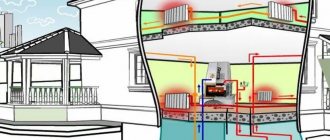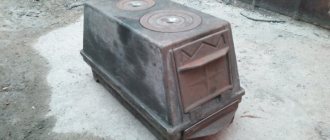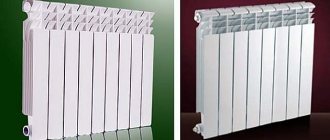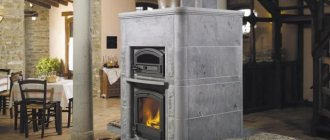Where are electric heating radiators used?
Currently, more and more owners of country houses are turning their attention to wall-mounted electric heating radiators. Several reasons contribute to this high demand:
- Lack of gas supply
- Expensive gas supply to the site
- High cost of connecting an electric boiler
- Difficulty in installing water heating systems
The common advantage of all electric batteries is their simplicity:
- Easy to install yourself
- Easy electrical connection, no expensive work
- No separate rooms (boiler rooms) required
- No problems with system freezing
- There are no complicated or expensive repairs; a broken device can be easily replaced with a new one
Below we will try to show you the advantages of each heating device option.
Calculation of the required number of radiators
To accurately determine the number of converter batteries needed to heat a room, many factors must be taken into account. First of all, the features of the building are taken into account: the material of the walls, the number of windows, their size, and the effectiveness of thermal insulation.
Accurate calculations are rarely made. In most cases, average indicators are used. In this case, the climatic features of the region matter.
For moderate latitudes, per 10 m2 of room area with a ceiling height of up to 3 m, 1 kW of heating unit power is sufficient. For northern regions, for example, for Yekaterinburg, this figure increases to 1.3 kW.
Wall-mounted electric convectors
It is generally accepted that such models operate on the principle of natural air circulation. Is it true?
Yes, but only partly. The thing is that for healthy natural air circulation, vertical ribs and a distance between them of at least 10 mm are required.
If the distance between the vertical sections is less than 10 mm, then the air flow speed slows down greatly, almost stops, and convector models do not have any sections at all!
Because the air flow slows down, the rate of heating of the room also slows down.
Convectors are a tin body with a hole at the bottom for cold air to enter, and “gills” at the top for heated air to exit. There is a heating element inside that heats the air mass passing through it.
It is worth noting that the heating element with a high temperature is in the open state, which leads to the combustion of dust particles in the air, resulting in the release of carbon monoxide.
Pros:
- Affordable price
- Easy installation
Minuses:
- Frequent breakdowns of heating elements
- Significant electricity consumption
- Dries the air and burns dust, which may cause headaches for sensitive people
- Poor convection, which is why fans are installed on some appliances
- Not suitable for continuous room heating
Energy saving
Energy savings in electric heaters occur by controlling the required room heating temperature using a thermostat. The device reaches the set temperature, the power turns off, and when the heater cools down, it turns on again. The choice of housing material and type of coolant are also aimed at energy saving.
Electric masonry radiators
Considering the types of electrical heating appliances, we could not pass by electric radiators made of stone. The line of these products is produced by a domestic manufacturer under the Heat Stone brand. Having studied this topic in detail, we have learned a lot of new and interesting things in the field of electric heating and are eager to share with you!
Watch a video review of heating with stone radiators Heat Stone
Stone batteries look like the familiar tubular or cast iron radiators. They have the same sections that we talked about above and the distance between each fin is about 20 mm, which creates very good natural convection. If you put your hand over the battery, you can feel how much hot air is blowing upward. This ensures the fastest possible heating of the room.
The heating element is located inside the stone and is completely isolated from the surrounding space, thereby preventing dust combustion, and fire safety is raised to the highest level of first class!
Watch a video review of heating with stone radiators Heat Stone
Heat Stone radiators heat the room primarily by convection, but in addition to this, they emit long-wave infrared radiation, similar to that emitted by humans. When exposed to such rays for a long time, a person feels better. Read more in our article “The health risks of infrared heating.”
Most often, stone radiators are used for the main heating of a house or cottage, since the cost of connecting them is several times less compared to a gas or electric boiler. Also, the high reliability of such a heating system lies in the fact that even if one device suddenly fails, the remaining radiators will not stop working. This is especially important when it’s frosty outside, and the heating system, despite the problems, continues to work.
Pros:
- Easy installation
- Economical and energy-saving heating system with thermostat, the stone cools down for a long time without wasting electricity
- Reliability, the heating system does not fail
- The cost of heating connection is several times less than an electric boiler or gas
- No pipes, water, boiler room
- Doesn't freeze
- Can be left unattended
Minuses:
- The price is higher compared to convectors
Pros and cons of convector radiators
Convector heaters are compact in size.
There are many arguments in favor of installing convector-type radiators.
- Simplicity and reliability of the design, which ensures long-term trouble-free operation of the equipment.
- Safety of use due to the relatively low surface temperature of the housing (in most cases the figure does not exceed +60 °C). But the temperature of the heated air can be significantly higher.
- Compact sizes. A convector radiator will take up no more space in the room than a more traditional steel or cast iron one. If necessary, you can choose a narrow model designed for installation under a low window.
- Ease of installation. To do this, just install the brackets, place the radiator on them and connect it to the heating source.
- Functionality. Manufacturers offer a wide selection of models, from which you can choose electronically controlled equipment. With its use, the user will be able to program the operation of the radiator and remotely adjust its parameters. Many models allow you to use an energy saving mode, which is especially relevant if the owners are away from home for a long time. For this purpose, the “Anti-freeze” mode is proposed, when turned on, the automation will maintain the temperature of the coolant at a level that will prevent the system from freezing.
The disadvantages of heaters include high energy consumption.
Before replacing previously installed radiators of a traditional design with convector heating devices, it is worth taking into account their disadvantages.
- High energy consumption: heating 10 m2 will require 1 kW/h.
- A significant difference between the temperature above and at floor level can cause discomfort. When choosing equipment whose design provides for the placement of outlet holes on the front wall, heating of the air layers will be more uniform.
- Low heating rate in the absence of a fan to force convection.
- In rooms with high ceiling heights, the use of convector heating is ineffective.
The constant movement of dust along with the movement of air in any case cannot have a positive effect on health. This problem may be especially relevant for young children or allergy sufferers.
Infrared wall heaters
Infrared devices are a panel with a heat exchanger inside. Such heaters heat with infrared radiation, which means the area of such devices must be larger than, for example, a quartz heater, which is unlikely to be able to warm anything.
Infrared lights also produce long-wave radiation that is pleasant to humans. But the convection of such devices will be comparable to a conventional convector, because they do not have sections, but they do not need this, since their main heating method is infrared radiation, which they cope with very well.
Pros:
- Pleasant warmth
- Acceptable price
- Easy installation
Minuses:
- Not suitable for main heating
- Poor convection
- Noticeable electricity consumption
Installation features
Water convectors
Installation and operation of heating equipment directly depends on the type and operating principle of the installed devices. When connecting a water radiator-convector, it is necessary to take into account the characteristics of the material from which it is made. The equipment is mounted on the wall using brackets. Special pipes are used to connect to the heating system and supply coolant. For joining, you can use steel or plastic pipes.
Installation of electrical equipment is much simpler and does not require the participation of specialists. Before installation, it is enough to take into account some safety rules. The distance to the floor should be more than 20 cm, to the outlet - from 35 cm, from the ceiling - from 55 cm, from the wall - less than 25 cm.
Self-installation is not permitted for gas units. Even a detailed study of information on specialized sites does not allow you to avoid errors, which is unacceptable from a security point of view.
Wall-mounted oil batteries: the worst?
We have included oil batteries in this list only to protect you from these heaters. We believe that such electrical appliances cannot even stand on a par with those listed above for some reasons that we know from practice:
- Fire hazardous
- Not reliable
- Can't stand intense work
You may think that we are wrong. After all, many of you have such heaters, and many of you have never failed, and some of you will say: “Yes, I have had such a battery in my dacha for 10 years and it still works!” And everything you say will be true, but only from a subjective point of view.
From an objective point of view, the majority of fires caused by electric heaters are oil heaters.
Their housing is often subject to depressurization and oil leakage. As soon as the oil level drops below the heating element and exposes it, it begins to reach a fire-hazardous temperature, and there is a danger of the oil catching fire.
Therefore, such heaters cannot be left unattended, much less used as the main heating. But in defense of these models, we can say that they really heat well, since they have numerous sections and heat primarily by convection.
If you decide to buy an oil heater, we recommend using it as additional heat for your room and only under human supervision.
Pros:
- Low price
- Heats the room quickly
- Mobility (usually used with wheels on legs)
Minuses:
- Fire hazardous
- Unreliable
- Human supervision required
- Consumes a lot
- Not suitable as main heating
Types of systems using convectors
A heating system based on the convection principle can be:
- water - using convection radiators, pipes and an electric, gas, solid fuel or liquid boiler;
- electric – implies the installation of electric convectors;
- gas - in this case, gas convectors are installed in the premises, which usually operate from bottled gas.
All of the above heat supply systems have distinctive characteristics.
Conclusion
We tried to describe in detail and from an objective point of view each type of radiator that we talked about today in this article. In future articles we will definitely cover the topic of electric heating in more detail. If you have any questions about this article or any objections to our above words, then feel free to write your feedback on what you read in the comments under this article, we will definitely answer your question or objection and together we will find an objective solution to common problems. Thank you for reading to the end!
Best regards, StroiDomEconom.RU experts!
Convector heating batteries
Many property owners prefer classic options for arranging heating in their own home or apartment. They lay pipelines, install a heating unit and a convector heating battery in the required quantity. A big advantage is the presence of a gas pipeline in the house, since this type of heating using a gas boiler is inexpensive and effective.
Heating based on equipment operating on liquefied gas is also economical. The next most economical ones are boilers operating on solid fuels. Heating using them will be free if there is a forest near the country house in which you can prepare firewood on the eve of winter. When it is not possible to chop logs, then it is better to purchase fuel in bulk, which will be much cheaper.
In this case, water heat supply involves the installation of convectors - heating radiators, which must be connected to a pipeline laid throughout the premises of the house. The heated coolant, after entering the batteries, heats up the metal surfaces, and then the heat is transferred to the surrounding air space.
Warm air rushes towards the ceiling, and cold air currents take its place. Temperature control in water systems is carried out using a boiler or taps and valves located on the batteries. Quite often, wall-mounted water heating convectors are installed, which are efficient and economical.
Taking into account the complexity of installation, the arrangement of such a heat supply option is considered optimal for buildings with a large number of rooms, since from a financial point of view, the installation of a large number of autonomously functioning electric convectors cannot be called justified.
Experts also recommend using water convector heating in houses connected to gas supply lines and for those property owners who have access to inexpensive types of solid fuel.
